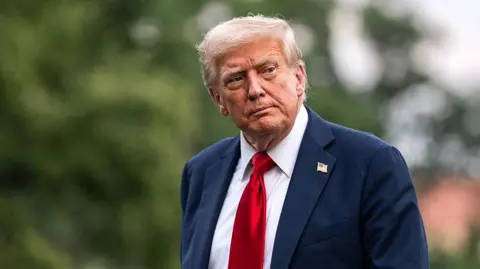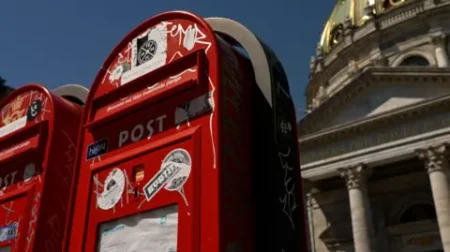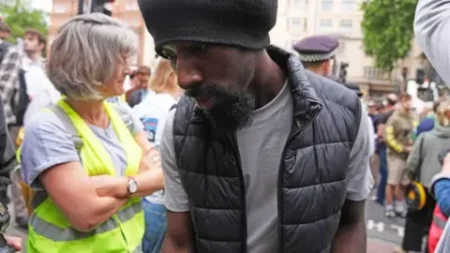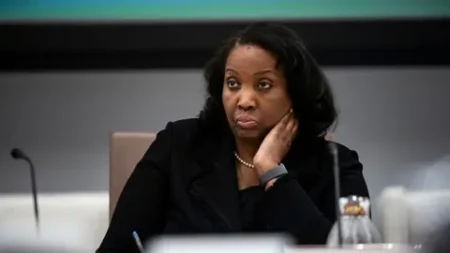Donald Trump is poised to undertake a historic visit to the Federal Reserve, marking the first time in nearly twenty years that a sitting president has set foot in this crucial institution. This visit underscores the increasing pressure Trump is placing on the Federal Reserve, particularly on its chair, Jerome Powell. The anticipation surrounding this event is magnified by the backdrop of Trump’s ongoing criticism regarding Powell’s management of monetary policy, especially in light of the Federal Reserve’s current interest rate strategy.
As part of his visit, Trump is expected to tour buildings at the Federal Reserve that are undergoing an extensive renovation project estimated to cost $2.5 billion (£1.8 billion). This project, which has faced allegations of mismanagement from the White House, is central to the tensions brewing between the Trump administration and Powell. Trump’s past public statements have included calls for more aggressive moves by the Fed to cut interest rates, arguing that such actions are crucial for the economy. His rhetoric has notably displayed a consistent pattern of frustration, as he feels Powell is not acting swiftly enough to manage interest rates amid evolving economic indicators.
This visit to the Federal Reserve is not just ceremonial; it represents only the fourth time a sitting president has visited the institution in modern history. The last presidential visit occurred in 2006 when President George W. Bush attended the swearing-in ceremony of Ben Bernanke, marking a long gap in such direct engagement between the executive branch and the central bank. Trump’s planned visit comes just ahead of a Federal Reserve meeting where policymakers are widely expected to maintain the current interest rates despite various financial pressures.
The Federal Reserve has indicated its willingness to accommodate the presidential visit, asserting its commitment to collaboration with the White House. However, questions linger about the implications of this visit for the broader economic landscape. As the Fed gears up for its meeting, the scrutiny on how it navigates monetary policy becomes ever more pronounced, especially given the current volatility in the financial markets.
One legal sticking point in this ongoing drama is the potential for Trump to remove Powell from office, a move that legal experts have broadly suggested would face substantial hurdles. The law stipulates that federal reserve governors can only be dismissed for “cause,” a measure designed to protect the Federal Reserve from political whims and to ensure that economic policy is crafted with, ideally, long-term stability in mind. Experts contend that the cost overruns associated with the renovation do not meet the “cause” threshold, and accusations of mismanagement, while politically potent, may not constitute grounds for dismissal under existing law.
Trump has also taken to personal attacks against Powell, labeling him with epithets such as “numbskull” and suggesting he exhibits a “stubborn” nature in handling Federal Reserve decisions. Despite these barbs, White House officials, including Press Secretary Karoline Leavitt, have claimed that there are currently “no plans” to fire Powell—notably while simultaneously insisting on a monetary policy that favors lower interest rates.
Critics of Trump argue that the ongoing focus on Powell serves as a strategic distraction amid worsening scrutiny regarding his political conduct and the handling of issues related to his administration. Some observers see a potential setup for Powell to become a scapegoat should economic conditions deteriorate, particularly with inflation levels being a point of contention and market stability increasingly a concern.
The Federal Reserve operates on principles that involve strategic use of interest rates to stabilize the economy. Typically, rates are reduced to stimulate growth during downturns, whereas increases aim to curb inflation. Trump’s proposed tax reforms and tariff impositions have contributed to operational challenges for the Fed, complicating the decision-making landscape surrounding interest rates. His belief that inflationary concerns have diminished contrasts sharply with the Fed’s outlook, as Powell seeks to maintain a cautious approach while evaluating economic data.
In summary, Trump’s forthcoming visit to the Federal Reserve represents a critical point in the intersection of political and economic spheres in the United States. This visit not only signals an unprecedented level of presidential engagement with the central bank but also reflects the mounting pressures faced by Powell and his team as they navigate a complicated economic landscape fraught with both opportunity and risk.












